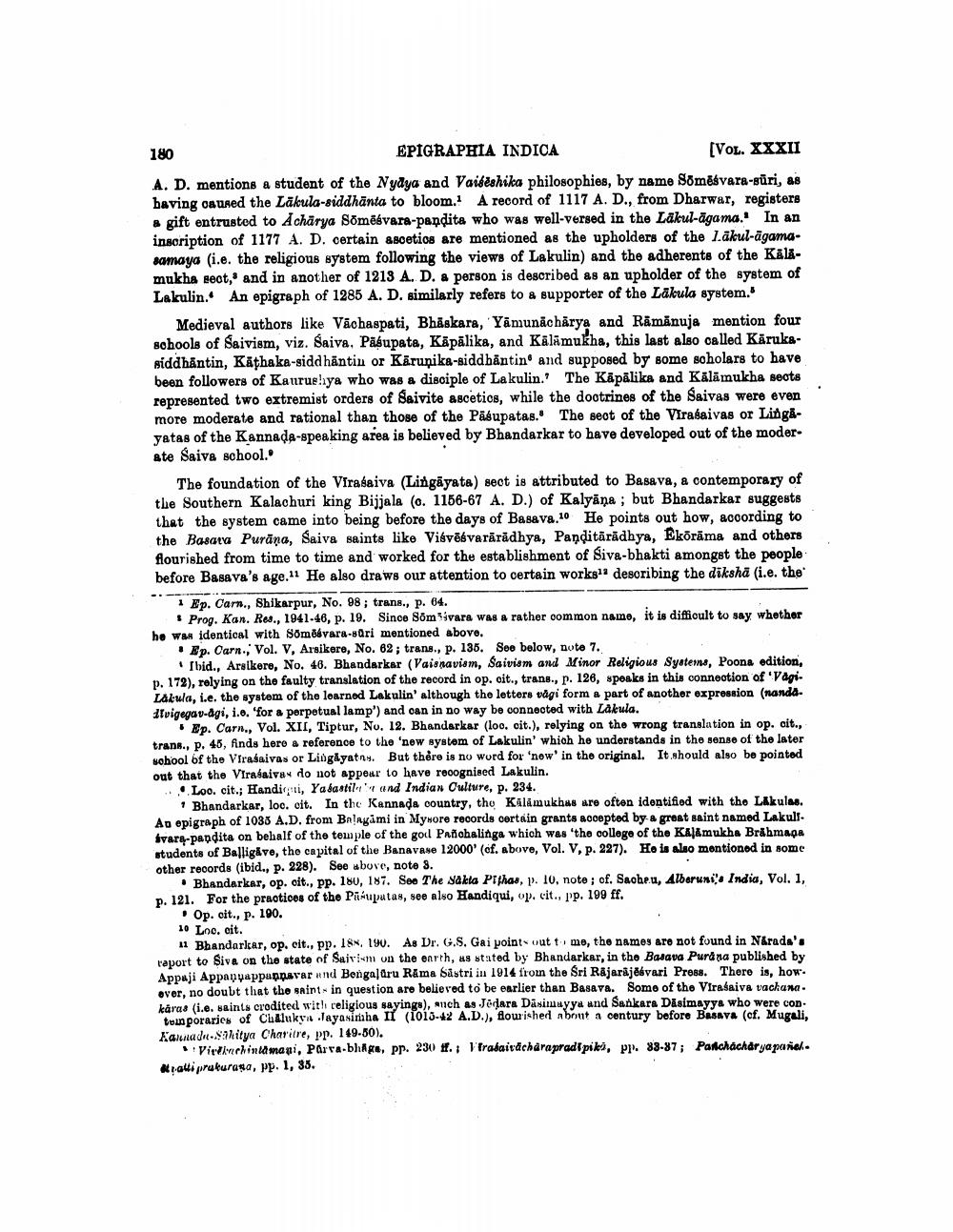________________
180
EPIGRAPHIA INDICA
[VOL. XXXII
A. D. mentions a student of the Nyaya and Vaiseshika philosophies, by name Somesvara-suri, as having caused the Lakula-siddhanta to bloom. A record of 1117 A. D., from Dharwar, registers a gift entrusted to Acharya Somesvara-pandita who was well-versed in the Lakul-agama. In an inscription of 1177 A. D. certain ascetics are mentioned as the upholders of the 1äkul-agamasamaya (i.e. the religious system following the views of Lakulin) and the adherents of the Kälämukha seot, and in another of 1213 A. D. a person is described as an upholder of the system of Lakulin. An epigraph of 1285 A. D. similarly refers to a supporter of the Lakula system.
Medieval authors like Vachaspati, Bhaskara, Yamunacharya and Ramanuja mention four schools of Saivism, viz. Saiva. Pasupata, Kāpālika, and Kälämukha, this last also called Kärukasiddhantin, Käthaka-siddhantin or Karupika-siddhantin and supposed by some scholars to have been followers of Kaurushya who was a disciple of Lakulin." The Käpälika and Kälämukha sects represented two extremist orders of Saivite ascetics, while the doctrines of the Saivas were even more moderate and rational than those of the Pasupatas. The sect of the Virasaivas or Lingayatas of the Kannada-speaking area is believed by Bhandarkar to have developed out of the moderate Saiva school.
The foundation of the Virasaiva (Lingayata) sect is attributed to Basava, a contemporary of the Southern Kalachuri king Bijjala (c. 1156-67 A. D.) of Kalyāņa; but Bhandarkar suggests that the system came into being before the days of Basava.10 He points out how, according to the Basava Purana, Saiva saints like Visvesvararadhya, Panditaradhya, Ekōrama and others flourished from time to time and worked for the establishment of Siva-bhakti amongst the people before Basava's age.11 He also draws our attention to certain works1 describing the diksha (i.e. the
1 Ep. Carn., Shikarpur, No. 98; trans., p. 64.
Prog. Kan. Res., 1941-46, p. 19. Since Som ivara was a rather common name, it is difficult to say whether he was identical with Someévara-sari mentioned above.
Ep. Carn., Vol. V, Arsikere, No. 62; trans., p. 135. See below, note 7.,
Ibid., Arsikere, No. 46. Bhandarkar (Vaisnavism, Saivism and Minor Religious Systems, Poona edition, p. 172), relying on the faulty translation of the record in op. cit., trans., p. 126, speaks in this connection of 'Vagi. Lakula, i.e. the system of the learned Lakulin' although the letters vägi form a part of another expression (nandadtvigegav-agi, i.e. 'for a perpetual lamp') and can in no way be connected with Lakula.
Ep. Carn., Vol. XII, Tiptur, No. 12. Bhandarkar (loc. cit.), relying on the wrong translation in op. cit., trans., p. 45, finds here a reference to the 'new system of Lakulin' which he understands in the sense of the later school of the Virasaivas or Lingayatns. But there is no word for 'new' in the original. It should also be pointed out that the Virašaivas do not appear to have recognised Lakulin.
Loo. cit.; Handiqui, Yasastila and Indian Culture, p. 234.
Bhandarkar, loc. cit. In the Kannada country, the Kälämukhas are often identified with the Lakulas. An epigraph of 1035 A.D. from Balagami in Mysore records certain grants accepted by a great saint named Lakull. ivara-pandita on behalf of the temple of the god Pañchalinga which was 'the college of the KAJAmukha Brahmaga students of Balligave, the capital of the Banavase 12000' (cf. above, Vol. V, p. 227). He is also mentioned in some other records (ibid., p. 228). See above, note 3.
Bhandarkar, op. cit., pp. 180, 187. See The Sakta Pithas, p. 10, note; of. Sacheu, Alberuni's India, Vol. 1, p. 121. For the practices of the Pasupatas, see also Handiqui, op. cit., pp. 199 ff.
Op. cit., p. 190.
10 Loc. cit.
11 Bhandarkar, op. cit., pp. 18, 190. As Dr. G.S. Gai points out to me, the names are not found in Narada's raport to Siva on the state of Saivism on the earth, as stated by Bhandarkar, in the Basava Purana published by Appaji Appayyappannavar and Bengalaru Rama Sastri in 1914 from the Sri Rajarajesvari Press. There is, how. ever, no doubt that the saint in question are believed to be earlier than Basava. Some of the Virasaiva vachanakaras (i.e. saints credited with religious sayings), such as Jodara Dasimayya and Sankara Disimayya who were contemporaries of Chalukya Jayasimha II (1015-42 A.D.), flourished about a century before Basava (cf. Mugali, Kannada-Sahitya Charitre, pp. 149-50).
Vivekachintamani, Parva-bhaga, pp. 230 ff.; Vtrabaivacharapradipiki, pp. 83-87; Panchacharya panel.. Balti prakurasa, pp. 1, 35.




